Design and Development of a Web-Based Plastic Waste Recycling Information System case study: Bali Pet Collection Center
on
JURNAL ILMIAH MERPATI VOL. 11, NO. 2 AUGUST 2023
p-ISSN: 2252-3006
e-ISSN: 2685-2411
Design and Development of a Web-Based Plastic Waste Recycling Information System case study: Bali Pet Collection Center
I Putu Jordi Astikaa1, Dwi Putra Githa a2, I Ketut Gede Darma Putraa3 aDepartment of Information Technology, Faculty of Engineering, Udayana University, Bukit Jimbaran, Bali, Indonesia, phone (0361) 701806
e-mail: 1astika.jordi@gmail.com, 2dwiputragitha@unud.ac.id, 3ikgdarmaputra@unud.ac.id
Abstrak
Perusahaan daur ulang plastik sebuah industri yang bergerak dibidang daur ulang sampah plastik menjadi sebuah biji plastik cacah yang dapat diproduksi kembali. proses bisnis yang berjalan masih menggunakan cara yang konvensional dalam melakukan kegiatan pencatatan pada perusahaan. Tujuan dari penelitian ini yaitu merancang dan membangun sistem informasi daur ulang sampah plastik berbasis website. Metode yang digunakan adalah waterfall sebagai metode pengembangan perangkat lunak. Pengujian sistem menggunakan metode black box testing dan user acceptance testing (UAT) serta diukur dengan metode Likert’s summated Rating (LSR). Hasil pengujian sistem dengan metode black box menunjukkan bahwa sistem berjalan dengan baik. Hasil pengujian sistem dengan metode UAT menunjukkan bahwa sistem secara keseluruhan mendapatkan respon sangat positif dan dinilai berhasil.
Kata kunci: Daur ulang, sistem informasi, waterfall, black box, user acceptance testing
Abstract
A plastic recycling company is an industry that specializes in recycling plastic waste into processable plastic pellets. The current business process still relies on conventional methods for recording activities within the company. The objective of this research is to design and develop a web-based information system for plastic waste recycling. The waterfall methodology employed as the software development method. The system is tested using black box testing and user acceptance testing (UAT) and measured using Likert's summated Rating (LSR) method. The results of the black box testing indicate that the system functions well. Furthermore, the results of the UAT demonstrate that the system as a whole receives highly positive responses and is considered successful.
Keywords: Recycling, information system, waterfall, black box, user acceptance testing
The development of technology today, to win the tight business competition, the application of information and communication technology is very important to be used as the main weapon to advance and develop an organization or company. The utilization of technology has become a reference in the progress of a company today. Information systems are also a system within an organization that meets the needs of managing daily transactions, supporting operations, managerial, and strategic activities of an organization, and providing certain external parties with the reports needed[1]
The Bali Pet Collection company is a business engaged in plastic waste management, supported by Danone Indonesia and PT Namasindo Plas. They have formed a partnership to process plastic waste. Bali Pet is capable of managing 300 tons of plastic packaging waste (bottles) every month. The presence of Bali Pet constitutes a Recycle Business Unit (RBU) that receives full support from Danone Aqua.
Plastic waste recycling, which involves plastic bottles, is the process of collecting, sorting, and reprocessing used plastic bottles into reusable raw materials, This recycling process helps reduce the amount of plastic waste that clends up in landfills or even pollutes
natural ecosystems such as rivers, seas, and forests. [2]. The types of plastic commonly used include PET or PETE (polyethylene terephthalate) and HDPE (high-density polyethylene), and many more types of plastic that people often use in their daily lives. Based on Indonesia's domestic waste statistics, plastic waste is ranked second at 5.4 million tons per year or 14% of total waste production[3]. A large amount of single-use plastics can then be collected for recycling into plastic seeds with the same benefits to fulfill human needs.[4]
Similar research on plastic waste recycling has been conducted by Aad Ediyansyah with the research title "Design of Web-Based Information System for the Sale of Used Bottles (PET) Recycling."[5] Additionally, similar research on plastic waste recycling has been carried out by Aji Saiful Anwar, Andy Prasetyo Utomo, and Fajar Nugraha with the research title "WebBased Information System for Plastic Waste Production in UD Bagas Mulya Mejobo Kudus."[6]. The difference in previous research, in terms of features and systems, is that they do not use an automated system that more encapsulates all business processes that occur with the website. The system can only manage production and sales activities, while the advantages of the current research lie in the set of features and their automated nature, such as buying, selling, recycling and reporting which cover all the business processes involved through an integrated website.
The author adopted the waterfall method as the research methodology for system development. The waterfall method is one application development model and a part of the Software Development Life Cycle (SDLC)[7]. Information exploration serves as a reference source to expand the received knowledge. Thus, technological advancements, theories, and relevant information that align with existing needs can develop[8].
The implementation or application phase is where the system design is transformed into executable code (program). This phase also involves consolidating all the prepared materials into a previously established design. The following is an illustration of the waterfall method's development process. will be explained in the Figure 1.

Figure 1 waterfall Method
-
Figure 1 the presentation of the waterfall system development method consists of four implementation stages that need to be followed[8].
Data collection using various methods. The methods employed for data collection included interviews and discussions, as well as observation and analysis methods.
The next step is the design phase, which involves designing the system based on the data collected from the company. The system design encompasses the design of Standard Operating Procedures (SOP), Use Cases, Context Diagrams, Data Flow Diagrams (DFD), Entity Relationship Diagrams (ERD), Physical Data Models (PDM), and wireframes[9].
This stage is the programming or coding phase, where the system design implemented results using the specified programming language. In this stage, the programming language used PHP with the visual studio code tools and the Laravel framework as the database connector[10][11].
The testing phase is conducted on each available feature and function to determine whether the system can perform effectively. The system was tested using the black box testing method[12]. Subsequently, further testing was conducted to assess the acceptance of the developed system by users within the company, using the User Acceptance Testing (UAT) approach[13].
This stage is crucial for conducting maintenance or upkeep by regularly updating the application to ensure proper maintenance after the testing phase.
In this research, data were obtained through a literature review, which included articles, scientific journals, research reports, books, and internet sources used as references for this study.
The processing of plastic waste into plastic pellets is one of the efforts made to combat environmental pollution. Plastic pellets serve as material for producing plastic-based products such as household items, electronics, automotive components, and other plastic-based products[14].
The information system is a component that consists of people, information technology, and work procedures that process, store, analyze, and disseminate information to achieve a goal. Information systems generate information from processed data in a form used for users. Information systems consist of Usefulness, Economy, Reliability, Customer Service, Simplicity, and Flexibility[15].
Laravel is a PHP framework released under the MIT license, with its source code provided on GitHub. Laravel built with the MVC (Model-View-Controller) concept, which helps organize code structure by separating the presentation layer from the data handling process, so that if there are changes in the view, they only need to be made in the view component data or processes can be implemented in Model and Controller components[16].
MySQL is a relational database management system that supports databases of relations or tables. MySQL is an open-source database creation program. MySQL databases are known for being powerful, stable, and user-friendly[17].
The system overview provides an overview of the system and application workflow[18]. The general overview of the plastic waste recycling information system based on a website, as implemented in the company, will be explained in the Figure 2.
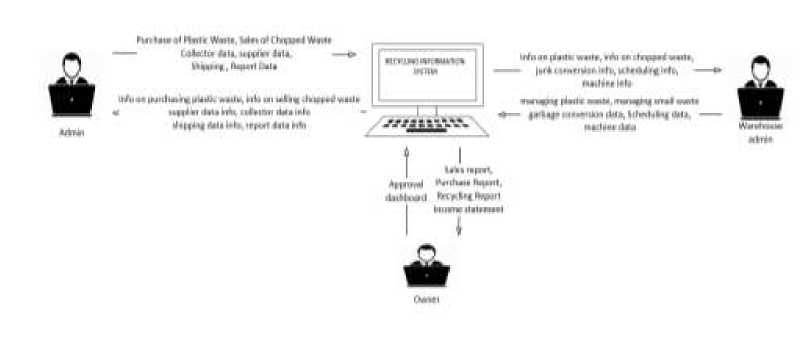
Figure 2 General Overview
Figure 2 represents the general interface of the research system. There are three entities: admin, Warehouse Admin, and manager. The admin can manage features related to purchases, sales, waste collectors' data, supplier data, deliveries, and reporting. The Warehouse Admin is responsible for plastic waste and pellet inventory, waste recycling, and recycling scheduling. The manager can manage user data, view purchases reports, sales, and recycling, analyze profit and loss, and access statistics from the system dashboard
Data Flow Diagram Level 0 depicts the planned system and serves as a foundation for the further development system. DFD level 0 of the plastic waste recycling information system is in Figure 3
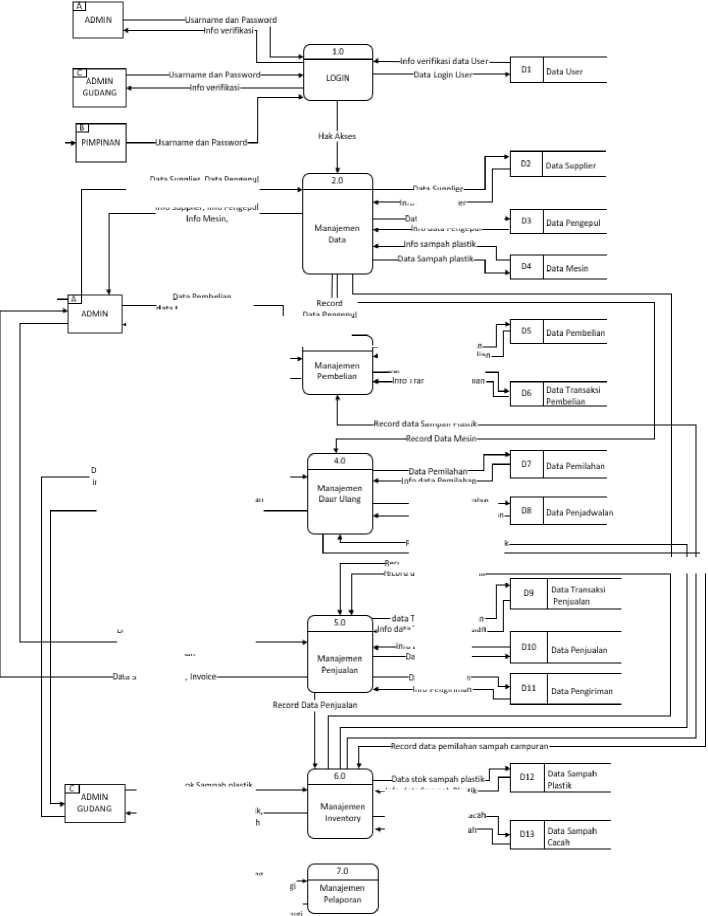
«-Info data Sampah Plastik
Laporan PembeIian1Laporan daur ulang.
Laporan inventori, Laporan penjualan, laporan Iaba Rugi
—Data stok sampah caci Info data sampah caca
■ Lsporan Akhir pembelian, Laporan akhir Daur Ulang Laporan akhir inventor ∣.Lapαraπ akhir penjualan. Laporan Iaba rugi
Stok Sampah plastik.
Stok sampah cacah
Jnfo Stok sampah plastik Info stok sampah cacah
Data Supplier, Data Pengepul ^ Data Mesin,
Info Supplier, Info Pengepul
—Data Supplie
nfo data Supplie
nfo data Pengcpul------
Jata Pembelian, data transaksi pembelian -
•-Info pembelian, transaksi pembelian—. j InvoiceTransaksiPembeIian
Data Sampah Cacah, Data Pemilahan, input data mesin. Data Penjadwalan
Info Sampah Plastik, Info Sampah cacah • InfoPemiIahan, Infodatamesin, Info Penjadwalan
Data satuan, data invoice Date, tatal, status -Data pengiriman
-Uata Sampah cacah,
Data Pengepul
—Data Pembeliar Jnfo data Pembelian
—Data Transaksi Pembelian-nfoTransaksi Pembelian.
Sampjh Plastik
nfo dat j Perniljhjn
JData Penjadwalan^— Jnfo Data Penpdwalan
data Sampah Ptaitik
Record Data Supplier------ ■ecord data Sampah Plastik-
Transaksi Penjualan Jnfo data Transaksi Penjualai
nfo Data Penjualan-ata Penjualan—
)ata Pengirunan
Hnfo Pengirimar
Figure 3 Data Flow Diagram Level 0
Figure 3 represents the display of the DFD level 0 of the system. There are six entities: admin, Warehouse, manager, supplier, waste collector, and scavenger. Furthermore, there are seven main processes: login, Data Management, Purchase Management, Recycling Management, Sales Management, Inventory Management, and Reporting Management. There are thirteen data stores: user data, supplier data, waste collector data, machine data, purchase transaction, purchase transaction data, sorting data, scheduling data, sales transaction, sales data, plastic waste data, pellet waste data, and delivery data.
The results and discussion section about the implementation and testing of the Plastic Waste Recycling Information System at Bali Pet Collection Center, including the implementation and testing of the developed application.
The login module is used by users, namely admin, Warehouse admin and owner, to access the Plastic Waste Recycling Information System based on the website. will be explained in the Figure 4.
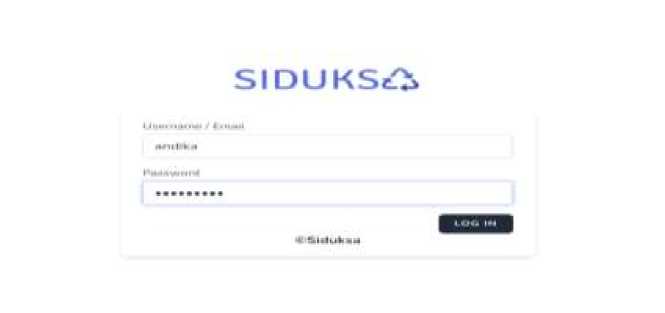
Figure 4 Login Page
Figure 4 displays the feature interface, which consists of a form containing the input fields for the Username/Email and the registered password in the system's database. After successful login, users can access the user features according to their respective roles.
The dashboard is the first page displayed after logging in to this dashboard, information regarding stock and sales data, as well as features specific to each role. will be explained in the Figure 5.
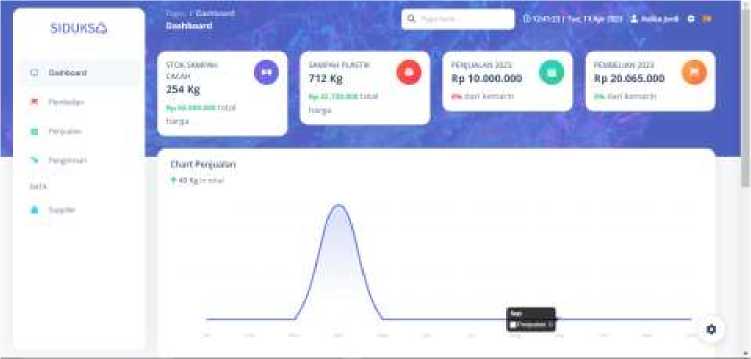
Figure 5 Dashboard information
-
Figure 5 shows the user dashboard, which displays various information about the stock of waste plastic and shredded waste. It also the total sales and purchases, a chart representing monthly sales. The dashboard provides information about user features and settings for configuring the sidebar
The scheduling feature is to schedule plastic waste recycling. This feature includes information on adding scheduling data, monitoring recycling results, and the recovery factor of the recycling process. will be explained in the Figure 6.

Figure 6 Recycling scheduling
Figure 6 shows the display of the scheduling data. It provides information about the recycling of plastic waste that has been inputted into the scheduling, such as initial stock, final stock, and the recovery factor or recycling recovery result. It also includes information about the recycling status, indicating whether it is finished or still in progress.
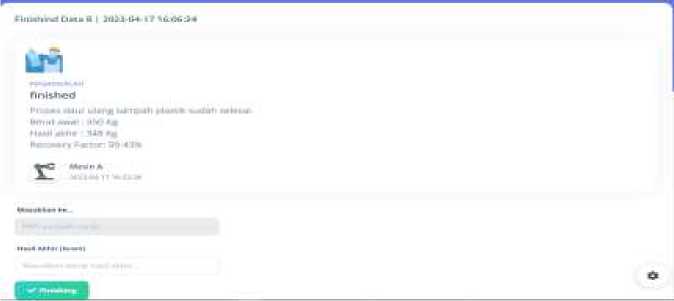
Figure 7 Recycling Scheduling Results
Figure 7 displays the results of recycling scheduling. It provides information about the initial weight and outcome process of recycling. The admin will input the weight of recycled waste, and the recovery factor from the recycling process automatically be calculated. The figure also presents information about the recycling schedule.
The sales feature is a feature used to make sales transactions of chopped waste to suppliers. There are several fields such as date, waste, quantity, supplier data, stock, and waste total and quantity inputted, and there are buy and print invoice buttons from sales transactions, Will be explained in the Figure 8.

Figue 8 Purchasing
Figure 8 is a display of chopped waste sales transactions. Admin inputs supplier data and chopped waste that is already available immediately to see the stock and price of the selected waste. Next is to choose the type of quantity and enter the quantity amount so that automatically the total price of the chopped waste.
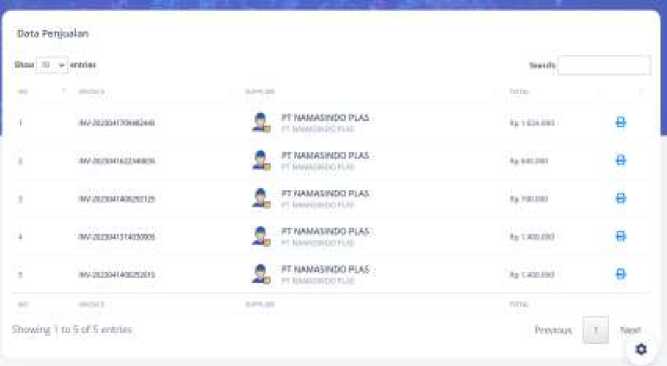
Figure 9 Purchase History
-
Figure 9 Is a display of the history of sales transactions There is invoice information from each sale, the name of the collector, the total transaction, and can also print the history of each transaction.
Testing conducted involves logic, process flow, and program functionality. System testing evaluates the suitability of the developed system with its initial objectives and usability. A black box testing method is employed, as shown in Table 1.
Table 1 Black Box Testing Result
|
Requirement |
Scenario |
Result |
Testing Result |
|
Login User |
user enters the correct username and passwords |
The user successfully logged in as roles |
Secceed |
|
Profile User |
user changes the old password to a new one by |
The user successfully changes the old password |
Secceed |
|
entering Current Password, to a new one and will New Password and Confirm automatically log out and | |||
|
Password |
return to the login. | ||
|
purchasing |
Fill in the purchase data of plastic waste purchased. |
The system successfully adds data and displays the message data successfully added |
Secceed |
|
sales |
Fill in the sales data of plastic shredded waste sold. |
The system successfully adds data and displays the message data successfully added |
Secceed |
|
shipping |
Fill in the shipment data of the shipped shredded waste. |
The system will successfully add delivery data and display the delivery data message successfully added. |
Secceed |
|
Manage data master |
Fill in the supplier/collector/ machine/user data that was added. |
The system will successfully add data and display the message data successfully added |
Secceed |
|
Sorting |
Filling in mixed waste sorting data. |
The system will successfully add mixed waste sorting data. |
Secceed |
|
Scheduling |
Filling in recycling scheduling data. |
The system will successfully add recycling scheduling data and display scheduling data saved successfully. |
Secceed |
|
Reporting |
Enter the start and end dates of the report and click export. |
The system will successfully display the report data and can be exported in excel. |
Secceed |
Table 1 The results of black box testing indicate that the running system is by the requirements. Evident from the testing of each feature, including user login, purchase, sales, delivery, master data management, sorting, scheduling, and reporting. Therefore, the system aligns with its objectives and functions well. Expected the system contributes to the company's activities effectively.
Testing Results Data using the User Acceptance Testing (UAT) method were measured using Likert’s Summated Rating (LSR) approach to compare the scores of each user. The following presents the LSR method's outcomes regarding the questionnaire for the Plastic Waste Recycling Information System testing.
-
1 .The total responses from the questionnaire results of testing the plastic waste recycling information system are as follows, considering the summation of the 4 aspects:
-
d. Total S Responses: 26+6+6+17 = 55
-
e. Total SS Responses: 22+30+18+29 = 99
-
2 .Total response scores from the questionnaire results of testing the plastic waste recycling information system:
-
e. Total SS Response Score: 99 x 5 = 495
-
f. Total Overall Score: 0+0+6+220+495 = 721
-
3 .Total score for each tester of the plastic waste recycling information system:
-
a. Maximum Score: 5 x 13 Number of Questions = 65
-
b. Minimum Score: 1 x 13 Number of Questions = 13
-
c. Median Score: 3 x 13 Number of Questions = 39
-
d. First Quartile Score: 2 x 13 Number of Questions = 26
-
e. Third Quartile Score: 4 x 13 Number of Questions = 52
-
4 .Total score for each tester of the plastic waste recycling information system:
-
a. Maximum Score: 65 x 12 testers = 780
-
b. Minimum Score: 13 x 12 testers = 156
-
c. Median Score: 39 x 12 testers = 468
-
d. First Quartile Score: 26 x 12 testers = 312
-
e. Third Quartile Score: 52 x 12 testers = 624
-
5.I nterpretation of the final score sum for UAT of the plastic waste recycling information system:
-
-
a. 624 ≤ score ≤ 780, indicating very positive (Program is considered successful)
-
b. 468 ≤ score ≤ 624, indicating positive (Program is considered moderately successful)
-
c. 312 ≤ score ≤ 468, indicating negative (Program is considered less successful)
-
d. 156 ≤ score ≤ 312, indicating very negative (Program is considered unsuccessful)
User Acceptance Testing on this plastic waste recycling information system has four aspects, Functional, appearance, security, and Benefits. Testing was carried out by 12 testers, namely officers or operational staff company The results of the testing frequency are in Table 2.
Table 2 UAT Frequency Result
|
No |
Question/Aspect |
Frequency of Response | ||||
|
Do Not |
Disagree |
Moderately |
Agree |
Strongly | ||
|
agree |
Agree |
Agree | ||||
|
1 |
Functional Aspects |
0% |
0% |
0% |
54,17% |
45,83% |
|
2 |
Display Aspect |
0% |
0% |
0% |
16,17% |
83,33% |
|
3 |
Security Aspect |
0% |
0% |
0% |
25% |
75% |
|
4 |
Benefit Aspect |
0% |
0% |
4,17% |
35,47% |
60,47% |
Table 2 The frequency of responses to the testing questionnaire for the plastic waste recycling information system. Based on the table above, the functional aspect received the highest response of 54.17% agree, the display aspect received the highest response of 83.33% strongly agree, the security aspect received the highest response of 75% strongly agree, and the benefit aspect received the highest response of 60.47% strongly agree.
system comparisons describe the comparison between this system and another similar system that hasalready been developed in previous research. System comparisons used 9 indicators and compared them with 2 similar systems. The system comparisions frequency are in Table 3
Table 3 System Comparisions
|
Design of WebBased Information System for the Sale of Used Bottles (PET) Recycling. |
Web-Based Information System for Plastic Waste Production in UD Bagas Mulya Mejobo Kudus. |
Design and Development of a Web-Based Plastic Waste Recycling Information System case study: Bali Pet Collection Center | |
|
User management |
Support |
Support |
Support |
|
features | |||
|
Manage ordering and payroll |
Support |
Support |
Not Supoort |
|
Manage purchases feature |
Not Support |
support |
support |
|
Features of managing sales |
Support |
Not support |
Support |
|
Features of managing recycling scheduling |
Not Support |
Support |
Support |
|
Features of managing waste stock |
Not Support |
Support |
Support |
|
Features of managing waste sorting |
Not Support |
Not support |
Support |
|
Delivery management feature |
Support |
Not support |
Support |
|
Reporting feature |
Not Support |
Support |
Support |
Table 3 presents a comparison between the web-based plastic waste management information system and similar systems. The systems used for comparison are the plastic bottle recycling sales information system (PET) and the plastic waste production information system at UD. Bagas Mulya Mejobo Kudus. The plastic waste recycling information system features a more comprehensive scope in plastic waste management. The plastic waste recycling system lacks features for order management and payroll, as it is dedicated solely to managing the recycling business processes from purchasing, recycling, sales, to delivery. The plastic waste recycling information system offers an advantage over previous research in the plastic waste sorting management process.
In designing and building this information system, several stages are carried out, namely in-depth needs analysis, in-depth needs analysis is carried out by interviewing, discussing, and observing the company, then designing system architecture such as overview, fishbone diagram, standard operation procedure (SOP), context diagram, and Data Flow Diagram (DFD). Database design includes an entity relationship diagram (ERD), and physical data model (PDM), and the next step is to build an information system, website development, and set up related functions This implementation process involves coding, testing, and iterative adjustments that are ultimately needed to evaluate and improve the system. The implemented system is a responsive website. This system can help the activities or business processes contained in the company. The business process consists of the process of purchasing plastic waste and selling shredded waste shipments carried out by the admin on the website, as well as managing master data suppliers, collectors, and machines. From the test results using black box testing, the website-based plastic waste recycling information system that was built functions properly according to the company's needs, then the data from the test results using the UAT method is measured overall to get a very positive response and is considered successful and automated system in place, many manual tasks can be reduced or eliminated. This can enhance employee productivity and lead to higher levels of job satisfaction. Implementing the system within the company provides employees with ease in managing record-keeping activities and offers business owners the convenience of viewing reports on purchases, sales, and recycling activities.
References
-
[1] R. Rasmila and R. Amalia, “Sistem Informasi Penentuan Persiapan Stok Obat
Menggunakan Weighted Moving Average,” Sistemasi, vol. 8, no. 3, p. 465, 2019, doi: 10.32520/stmsi.v8i3.547.
-
[2] U. Rohmah, “Eksplorasi material daur ulang sampah polystyrene (PS) menggunakan
metode material-driven design,” Prod. J. Desain Prod. (Pengetahuan dan Peranc. Produk), vol. 5, no. 2, pp. 91–100, 2022, doi: 10.24821/productum.v5i2.7856.
-
[3] M. Dani Chairudin, N. B. Ginting, and H. Fajri, “Information System for Selection of
Production Line for Plastic Item Injection Machine Number A36 Using Priority Scheduling Method,” INTENSIF J. Ilm. Penelit. dan Penerapan Teknol. Sist. Inf., vol. 4, no. 2, pp. 232–246, 2020, doi: 10.29407/intensif.v4i2.14321.
-
[4] H. Susanto, A. Daryanto, and D. Iwan Setiawan, “Pengembangan Model Bisnis Daur
Ulang Sampah Plastik di CV Majestic Buana Group Business Model Development of Plastic Recycling Business in CV Majestic Buana Group,” J. Manaj. Pengemb. Ind. Kecil Menengah, vol. 12, no. 1, 2017, [Online]. Available: http://journal.ipb.ac.id/index.php/jurnalmpi/
-
[5] Aad Ediyansyah, “Perancangan Sistem Informasi Penjualan Daur Ulang Botol Bekas
(Pet) Berbasis Web,” J. Ris. Inform., vol. 1, no. 1, pp. 11–16, 2018, doi: 10.34288/jri.v1i1.5.
-
[6] F. N. Aji Saiful Anwar, Andy Prasetyo Utomo, “Sistem Informasi Produksi Plastik Pada
UD. Bagas Mulya Mejobo Kudus Berbasis Web,” SITECH J. Sist. Inf. dan Teknol., vol.
-
1, no. 1, pp. 49–56, 2018, doi: 10.24176/sitech.v1i1.2275.
-
[7] P. D. . Silitonga and D. E. R. Purba, “Implementasi System Development Life Cycle
Pada Rancang Bangun Sistem,” J. Sist. Inf. Kaputama, vol. 5, no. 2, pp. 196–203, 2021.
-
[8] L. D. B. JeHrey L. Whitten, Analysis and Design Methods., vol. 18, no. 4. 2004. doi:
10.5459/bnzsee.18.4.329-336.
-
[9] M. Febrilian, D. Syahputra, B. T. Hanggara, and B. S. Prakoso, “Analisis dan
Perancangan Sistem Informasi Penjualan dengan Metode FAST pada CV Ide Karya Semesta,” J. Pengemb. Teknol. Inf. dan Ilmu Komput., vol. 6, no. 2, pp. 929–938, 2022.
-
[10] F. Sujatmiko and D. F. Suyatno, “Rancang Bangun Sistem Informasi Manajemen Aset Alat Kantor Berbasis Website menggunakan Framework Laravel dan Metode LIFO,” Jeisbi, vol. 02, no. 04, p. 2021, 2021.
-
[11] N. F. Yeni and A. Huda, “Rancang Bangun Sistem Informasi Pengalaman Lapangan Industri Fakultas Taknik Berbasis Web Menggunakan Framework Laravel Fakultas Teknik Universitas Negeri Padang khususnya Program Studi Pendidikan,” vol. 6341, no. November, pp. 60–70, 2021.
-
[12] B. A. Priyaungga, D. B. Aji, M. Syahroni, N. T. S. Aji, and A. Saifudin, “Pengujian Black Box pada Aplikasi Perpustakaan Menggunakan Teknik Equivalence Partitions,” J. Teknol. Sist. Inf. dan Apl., vol. 3, no. 3, p. 150, 2020, doi: 10.32493/jtsi.v3i3.5343.
-
[13] E. Listiyan and E. R. Subhiyakto, “Rancang Bangun Sistem Inventory Gudang Menggunakan Metode Waterfall Studi Kasus Di Cv. Aqualux Duspha Abadi Kudus Jawa Tengah,” KONSTELASI Konvergensi Teknol. dan Sist. Inf., vol. 1, no. 1, pp. 74–82, 2021, doi: 10.24002/konstelasi.v1i1.4272.
-
[14] A. F. Ikhsanudin, P. H. Tjahjanti, A. Fahruddin, A. Akbar, and R. E. Fernanda, “Pengkajian Briket dari Campuran Sampah Botol Jenis PET dan Bahan Natural Dengan Perekat Kanji,” Justek J. Sains dan Teknol., vol. 5, no. 2, p. 73, 2022, doi: 10.31764/justek.v5i2.9971.
-
[15] J. S Pasaribu, “Development of a Web Based Inventory Information System,” Int. J. Eng. Sci. Inf. Technol., vol. 1, no. 2, pp. 24–31, 2021, doi: 10.52088/ijesty.v1i2.51.
-
[16] A. Sunardi and Suharjito, “MVC architecture: A comparative study between laravel framework and slim framework in freelancer project monitoring system web based,” Procedia Comput. Sci., vol. 157, pp. 134–141, 2019, doi: 10.1016/j.procs.2019.08.150.
-
[17] M. Daniel Dido Jantce TJ Sitinjak and Suwita Jaka, “Analisa Dan Perancangan Sistem Informasi Administrasi Kursus Bahasa Inggris Pada Intensive English Course Di Ciledug Tangerang,” J. IPSIKOM, vol. 8, no. 1, 2020.
-
[18] I. P. Somadanayasa, D. P. Githa, and A. A. N. H. Susila, “Rancang Bangun Supply Chain Management Pada Pia Cemerlang Berbasis Website,” JITTER-Jurnal Ilm. Teknol. dan Komput., vol. 3, no. 1, 2021.
Design and Development of a Web-Based Plastic Waste Recycling Information System
case study: Bali Pet Collection Center (I Putu Jordi Astika)
138
Discussion and feedback